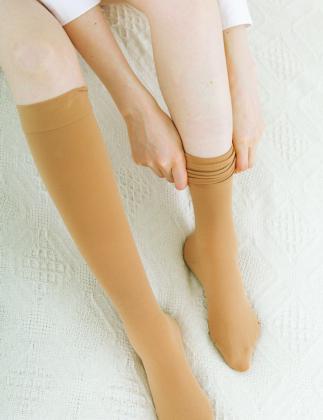MY RIGHT LEG WASN’T WORKING TOO WELL because of my multiple sclerosis (MS). It didn’t bend well, it was weaker than my left leg, and I had a condition called foot drop. I visited my neurologist and got a prescription for an AFO (ankle foot orthotic, or brace). He commented that my right leg, the one that needed the brace, had a little edema—slight swelling. He told me that wearing compression socks might help to get the swelling down. It was funny—he showed me that he, too, was wearing compression knee socks!
I visited my orthotist (the AFO maker) who told me to start wearing the compression socks and see him in a few weeks. So, I first had to purchase some socks and wear them every day for a few weeks. I went to a local pharmacy where a staff member, a certified fitter, measured me. He chose my size and demonstrated the proper technique to put the stockings on. It seemed pretty straightforward, and I went home with my two new boxes of extreme spandex! No problem, I thought. I can do this.
What planet was I living on?! The next day, after my shower, I made sure my feet to my knees were dry. I gathered up the new stockings, turned them inside out to the heel, and got them on in a matter of minutes. Thirty-five minutes! I struggled to place the stockings over my feet. When finally a stocking was over my foot, I pulled it up to about “two fingers” under my knee. I did the other foot, and it took a little less time. I smoothed out the stockings and got dressed.
The socks felt good, and I felt support from them. When I arrived at work, I checked out my stockings in better light and saw I had placed a black sock on my right foot and a navy blue one on the other. I was worried because my ankles looked bulbous, like little potatoes, until I realized that I had not properly pulled the heel of the sock so that it fit on my heel. I left the stockings as they were, determined that I would master this medical challenge in the future.
After about a week, my swollen right foot and leg looked normal. I have been able to place the compression socks on a little faster than that first time. Fitting the heel of the sock on my heel is still a challenge. That is next on my medical bucket list.
Designed for compression therapy, compression stockings are specially made, snug-fitting, stretchy socks constructed using elastic fibers or rubber. These fibers apply gentle pressure to your legs and ankles, promoting blood flow from your legs to your heart. Compression socks can also reduce pain and swelling in your ankles and legs.
WebMD explains that the pressure these stockings put on your legs helps your blood vessels work better. The arteries that take oxygen-rich blood to your muscles can relax so blood flows freely. The veins get a boost pushing blood back to your heart.
Because the blood keeps moving, it’s harder for it to pool in your veins and make a clot. If a clot forms and breaks free, it can travel with your blood and get stuck somewhere dangerous, like your lungs. Clots also make it harder for blood to flow around them, which can cause swelling, skin discoloration, and other problems.
Compression stockings can also keep your legs from getting tired and achy, ease swelling in your feet and ankles, and help prevent and treat spider and varicose veins. They may even stop you from feeling light-headed or dizzy when you stand up.
Many people use compression socks, including individuals who have or are at risk of developing circulation problems such as deep vein thrombosis (DVT, which can cause blood clots) or varicose veins, for example people with diabetes, people who’ve just had surgery, those who can’t leave their bed or who have trouble moving their legs, people who stand all day, athletes, pregnant women, and those who spend long stretches of time on airplanes, such as pilots.
Compression wear has also been adopted by the sports-science industry. Various garments have been developed to improve the efficiency of muscles by stabilizing them and improving circulation/lactic acid removal.
Compression garments come in different lengths to cover different parts of your body. For DVT, most stockings go to just below the knee, but you can get thigh-highs and waist-length tights, too.
They also have different levels of pressure, measured in mmHg (millimeters of mercury). Stockings should feel snug but not painfully tight. Mild compression, with lower numbers, is usually enough to keep you comfortable on your feet at work. You’ll need higher numbers with a firmer fit to prevent DVT.
There are different types of compression socks as well: Graduated compression stockings are the most common and are available in a wide range of tightness. They tend to be tighter around the ankles and get looser the higher they’re pulled.
Thrombo-embolic-deterrent (TED) hose, or anti-embolism stockings, are designed for after surgery and when you need to stay in bed. They can help maintain blood circulation and lower the odds of severe swelling.
If you need compression stockings for medical reasons, your medical professional will measure your legs and prescribe the right ones for you.
Today, compression stockings come in a wide range of opacities, colors, styles, and sizes, making them virtually indistinguishable from regular hosiery or socks. I bought several pairs online where the pattern and colors are pretty nice and normal.
Overall, I like what medical spandex (as I call it) can do for my body. I have mastered the 20 mmHg socks. I do not know how I would do with the heavier ones.
Talk with your healthcare professionals for help with all aspects of these squeezer socks!
Sister Karen Zielinski is the Director of Canticle Studio. Canticle Studio is a part of the Sisters of St. Francis of Sylvania, OH’s overall advancement effort and has a mission of being a creative center where artists generate works, products, and services in harmony with the mission of the Sisters St. Francis. She can be reached at kzielins@sistersosf.org or 419-8243543.
✲


